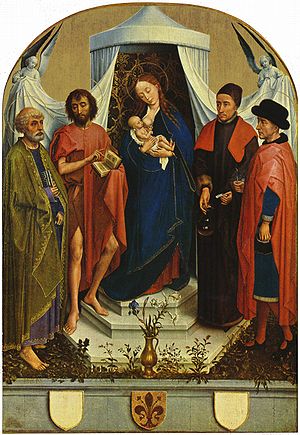- Medici Madonna (van der Weyden)
-
Medici Madonna 
Artist Rogier van der Weyden Year c. 1460–1464 Type Oil on panel Dimensions 61.7 cm × 46.1 cm (24.3 in × 18.1 in) Location Städel, Frankfurt The Medici Madonna is an oil-on-panel painting by the Netherlandish artistRogier van der Weyden, dating from around 1460–1464 and housed in the Städel, Frankfurt, Germany.
The work is known to have been commissioned by the Medici family in Florence, as testified by the Florentine coat of arms with a red lily at the center of the lower step. The work has been variously dated from 1450–1451, when the artist travelled to Rome visiting several Italian courts, or from 1460–1464, the same years of the Lamentation of Christ, inspired by Beato Angelico and now at the Uffizi.
Description
Above a gold background, van der Weyden painted a baldachin lined with precious damask cloth, under which are the Virgin with Child, St. Peter, St. John the Baptist (patron saint of Florence), St. Cosmas (a protector of the House of Medici), and St. John the Evangelist. Cosmas is portrayed while putting a coin in a handbag hanging from his belt, a reference of his legend, according ot which he had accepted a small sum for a medical performance, causing rage in his brother Damian.
In the foreground is a still life with the artist's typical attention to natural details. In the centre is a gilt metallic amphora, in which are several lilies: the white ones symbolize the Virgin's purity, while the red ones are another reference to Florence.
Sources
- Campbell, Lorne (2004). Van der Weyden. London: Chaucer Press. ISBN 1-9044-4924-7.
Rogier van der Weyden Single religious
worksVirgin and Child with Saints (1435-1438) · The Magdalen Reading (fragment, c. 1435-1438) · The Descent from the Cross (c. 1435–38) · Saint Luke Drawing the Virgin (c. 1435–40) · Christus on the Cross with Mary and St John (c. 1440) · Head of the Virgin (c. 1460) · Lamentation of Christ (c. 1460-1463) · Medici Madonna (c. 1460-1464) · Pietà with Saint Dominic, Saint Jerome and a Donor (c. 1464)
Diptychs Calvary Diptych (c. 1464-65)Triptychs Miraflores Altarpiece (c. 1442-45) · Seven Sacraments Altarpiece (c. 1448) · The Braque Triptych (c. 1452) · The Last Judgment (1450s) · Saint Columba altarpiece (c. 1455) · Altar of Saint John (c. 1455) · Nativity Triptych (1460s)Portraits Portrait of a Woman (c. 1435) · Portrait of Isabella of Portugal''(c. 1445-1450) · Portrait of Charles the Bold (1460) · Portrait of Antoine, the 'Grand Bâtard' of Burgundy (c. 1460) · Portrait of Francesco d'Este (c. 1460) · Portrait of a Lady (c. 1460) · Portrait of Philip de Croÿ (c. 1460)Categories:- Rogier van der Weyden paintings
- 1460s paintings
- Paintings of the Virgin Mary
- Collections of the Städel
Wikimedia Foundation. 2010.
